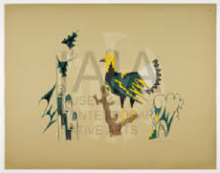Article
In Native American social structures, a clan is an interrelated social group whose connections derive from parentage as well as kinship. Clan configurations develop and are expressed uniquely in different indigenous groups, and each tribe is comprised of numerous various clans. Clan names often originate in the natural environment of the tribe’s homeland, and refer to place names, fauna and flora, or significant natural phenomena.
The Turkey Clan is probably named after the bird that is commonly found across Southwestern parts of the U.S. The Navajo, Hopi, Zuni and other pueblo peoples all have a clan by that name as part of their greater system of familial and kinship structures.
"Untitled (turkey or grouse, offset lithograph by Jose Encarnacion Pena," SILD-62; Gift of William and Luanna Johnson and the IBM Corporation, 1993; Courtesy of the Museum of Contemporary Native Arts, Santa Fe, NM.
Manuscripts
A08 The Ghostway (05-03) p. 45
A08 The Ghostway (05-03) p. 86
A08 The Ghostway (05-03) p. 87
A08 The Ghostway (05-03) p. 94
A08 The Ghostway (05-03) p. 131
A08 The Ghostway (05-03) p. 167
A08 The Ghostway (05-03) p. 173
A08 The Ghostway (05-03) p. 221
A08 The Ghostway (05-03) p. 225
A08 The Ghostway (05-03) p. 226
A08 The Ghostway (05-03) p. 237
References
Lowie, Robert Harry
1929 Notes on Hopi Clans. Anthropological Papers of the Museum of Natural History. New York: American Museum of Natural History.
Kroeber, Alfred Louis
1917 Zuñi Kin and Clan. Anthropological Papers of the American Museum of Natural History. New York: The Trustees.
Reichard, Gladys Amanda
1928 Social Life of the Navajo Indians: With Some Attention to Minor Ceremonies. New York: Columbia University Press.
Stevenson, Matilda Coxe Evans
1904 Zuni Indians: Their Mythology, Esoteric Fraternities, and Ceremonies. U.S. Bureau of American Ethnology. Twenty-Third Annual Report. 1901-1902. Washington: Government Printing Office.
Witherspoon, Gary
1975 Navajo Kinship and Marriage. Chicago: University of Chicago Press.

